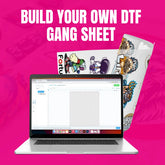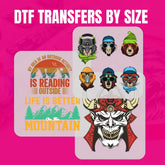DTF Transfers Ready to Press vs. DIY Transfers: Pros and Cons
If you are learning about custom printing, you may have encountered the DTF transfers ready to press term. These transfers ease the print process, so they are becoming rather popular. Still, how do they measure against creating custom DTF transfers at home? Choosing between buying DTF transfers ready to press or making your own will affect your success whether you own a print company or work from your garage. Using actual statistics, facts, and experience-backed insights, this article will carefully dissect both approaches to help you select appropriately.
Why Are DTF Transfers Ready To Press A Great Option?
DTF offers immediate convenience by being ready for the press. Printing film, applying powder, or curing the ink are not causes for concern. All is done for your benefit. They are already ready when you get them; only heat and press. This approach saves a lot of time for busy people and small stores. Even enormous quantities are manageable, given pressing takes as little as 10 seconds. A DTF gang sheet helps many stores increase the number of photos they obtain on each sheet. This rapidly applies dtf heat transfers over several objects and helps save money. Using ready-to-press transfers can cut manufacturing expenses by around 30% compared to in-house printing when considering time, materials, and machine maintenance.
What Are The Downsides Of Choosing Ready To Press Over DIY?
Although DTF transfers ready to press are handy, they restrict flexibility. Once your order is submitted, last-minute adjustments are impossible. You will have to rearrange if you must change a name or color. If you are managing customized one-off projects, that is not ideal. Also, less control over the process is involved. Should the seller utilize inferior films or inks, your results could suffer. Remember also that even pre-made transfers still need good technique if you want to know how to press dtf transfer mistakes. Whatever the printing quality, bad heat, pressure, or timing can destroy a transfer.
Another problem is color mismatch. Occasionally, the colors on your screen will not match what you get back. This is common in DTF printing and can occur even with seasoned vendors. Professionals often ask for test prints before ordering large quantities.
What Makes DYI Custom DTF Transfers Worth Considering?
Customizing DTF transfers on your own gives you more control. You handle the design, print, powder, and cure processes from beginning to end, making more customization and quick changes possible. DIY might be more suited for you if you run a company that depends on regular updates, such as sports jersey names or number changes.
A decent setup, including a printer and DTF gang sheet layout, allows you to execute several dozen transfers daily. This setup is conducive for those who wish to experiment or hone their abilities. Furthermore, versatile DTF heat transfers allow you to apply them to wood, cloth, and more.
According to statistics, home-based DTF printing companies expanded by more than 35% last year, primarily due to the affordability of DIY printing. That includes improved software, smaller printers, and less expensive access to DTF transfer sheets and inks.
What Are The Drawbacks Of Doing It All Yourself?
Making your print requires additional effort. You need the correct tools: film, hot melt powder, a DTF printer, and a curing environment. Indeed, you will also have to learn the proper DTF transfer technique. The prints could fade, crack, or peel off if you get it wrong. Do-it-yourself projects can carry hazards, including powder spillage, uneven drying, and perhaps waste from mistakes. You'll spend time calibrating, troubleshooting, and maintaining.
Finding the proper settings for color accuracy also requires work. Until you adjust your workflow, your prints could appear darker or lighter than planned. Newbies usually struggle with this and spend resources before learning it well.
Conclusion
DIY bespoke DTF transfers have advantages and trade-offs, as do ready-to-press DTF transfers. If you choose a good source, ready-to-press guarantees a professional outcome and saves time. Though it takes time to get good, DIY offers flexibility, cost control, and hands-on creativity. Whether you apply DTF heat transfers on challenging fabrics or a DTF gang sheet, your success relies on your equipment and process management.
Still figuring out which route to go? Explore high-quality options and trusted services at DTF Transfer Art. They've got what you need to press with Confidence.
- Blended fabrics for DTF
- bulk dtf transfers
- bulk printing
- cost-efficient printing
- Cotton for DTF
- Custom apparel
- custom apparel printing
- Custom clothing printing
- custom gangsheet
- Custom gangsheet DTF transfer sheets
- Custom gangsheet printing
- Custom Gangsheets
- custom heat transfers
- Custom iron patches
- custom prints
- decal transfer
- decal transfers
- Design preparation
- Digital printing
- Direct-to-Film Transfer
- dtf business
- DTF gangsheet
- DTF Heat Press
- dtf print shop
- DTF printer supplier
- DTF Printing
- dtf transfer
- dtf transfer art
- dtf transfer film
- dtf transfer instructions
- dtf transfer paper
- DTF transfer paper suppliers
- dtf transfer printer
- dtf transfer sheets
- DTF transfer supplier
- DTF transfer wholesale
- dtf transfers
- dtf transfers near me
- dtf transfers ready to press
- dtf transfers wholesale
- DTF vs Screen Printing
- DTF vs Vinyl
- DTF vs. iron-on
- dtf wholesale
- Fabric type (cotton
- gangsheet printing
- heat press printing
- Heat press settings
- Heat settings for DTF
- heat transfer decals
- heat transfer method
- heat transfer printing
- Heat transfers
- hoodie printing
- Hoodies
- hot peel DTF
- iron-on decals
- Leather DTF transfers
- Local print shops
- Mild detergent for DTF prints
- Nylon DTF transfer
- Peeling or cracking prevention
- Polyester for DTF
- premium DTF transfers
- print on demand
- Print shops near me
- Quality printing
- reliable DTF transfer printer supplier
- Screen printing
- Spandex DTF transfer
- sticker printing
- Stretch fabrics DTF
- Sublimation printing
- t shirt printing
- T-shirts
- Textile printing
- Tote bags
- Transfer printing
- trustworthy DTF transfer supplier
- vinyl decals
- Washing care for DTF prints
- what is dtf transfer






